#coral reef invertebrates
Explore tagged Tumblr posts
Photo
You can read more about one species, the greater blue ringed octopus, here!

Meet blue-ringed octopuses, members of the genus Hapalochlaena. They inhabit coral reefs in the Indian and Pacific oceans. Though they usually measure less than 8 inches (20. 3 cm) at their largest, keep your distance: Blue-ringed octopuses are among the world’s deadliest cephalopods. Their venomous bite can instantly paralyze, and even kill, a human. Photo: Angell Williams, CC BY 2.0, flickr https://www.instagram.com/p/CqggM3uqGEK/?igshid=NGJjMDIxMWI=
#blue ringed octopus#octopoda#Octopidae#blue ringed octopi#octopi#octopus#cephalopods#mollusks#invertebrates#marine invertebrates#coral reef invertebrates#indian ocean#pacific ocean#indo-pacific
539 notes
·
View notes
Text
Wet Beast Wednesday: Christmas tree worm
Merry Christmas from the ocean! For this festive occasion, I’ve chosen to cover an animal that certainly has the spirit of the season. The Christmas tree worm is the person who keeps their Christmas lights up all year of the sea and today we’re going to see what makes them tick.
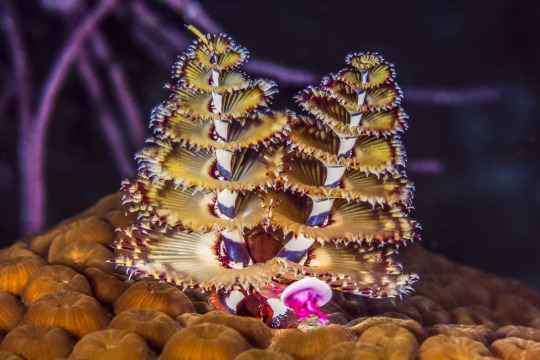
(Image: the crown of a Christmas tree worm. It appears as two stalks emerging from amongst coral polyps. Small feathery, appendages emerge from the stalks in a spiral formation going up them. They are yellow, with brown tips. A smaller, round structure is near the base of the trees. End ID)
The Christmas tree worm (Spirobranchus giganteus) is a polychaete worm of the tube-building fan worm clade Sabellida. While they are called giganteus, that’s only relative to other fan worms as they max out at about 3.8 cm (1.5 in) long. Being tube worms, they build a tube of calcium carbonate that they live in. This tube provides protection for the worm, who can retreat into it if threatened by predators. Polychaetes are defined by the paired bristle-like chaetes on each body segment, which are often used for locomotion. Tube worms like the Christmas tree worm lack these kind of locomotive appendages as they spend their entire lives in their tubes.

I couldn't find a full-body picture of a Christmas tree worm outside of its tube, so this is the best you get. (Image: Serpula vermicularis, a member of the same family of tube worms as the Christmas tree worm, removed from its tube. It is a short, segmented worm with a plug on a stalk and a crown consisting of long, feathery tentacles arranged differently than those of a Christmas tree worm. End ID)
The feature that gives these worms their common name is a pair of feathery, spiraling structures that emerge from the head and look quite a bit like tiny, colorful fir trees. These structures, called crowns, are heavily modified version of mouth appendages called prostomial palps. The feathery bits are tentacles called radioles. The crown is usually the only part of the worm visible, with the rest of its body safely in the tube. The crown is used both for feeding and respiration, as it can perform gas exchange with the water like gills. Christmas tree worms, like other fan worms, are filter feeders. They expose their crows to the water and wait for edible plankton and bits or organic detritus to get caught by the radioles. Cilia then transports the food down to the mouth. Christmas tree worms have a modified radiole called an operculum that acts like a lid to the front of the tube, closing it off when the worm retreats. The crown also has light-sensing structures, allowing it to detect light and shadow. The visual capabilities of these eye spots is poorly studied. The crown makes up about a third of the body length and can come in a wide variety of colors. It can regenerate if damaged.
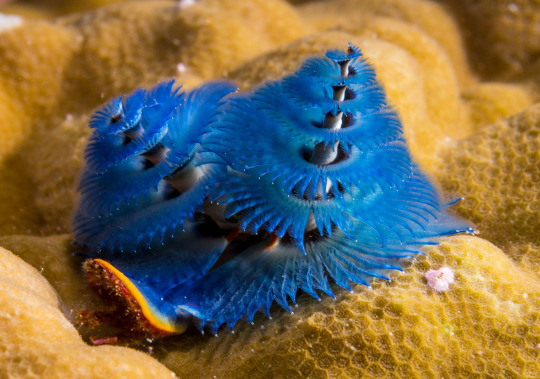
(Image: a blue-crowned Christmas tree worm emerging from yellow coral. End ID)
Christmas tree worms are found across most of the world, from the Caribbean to the Indo-Pacific, in tropical waters. They are coral reef dwellers who live in burrows built into had corals. Brain coral species are their preferred hosts, but they can live on other corals and have been reported living in sponges and on giant clams. Christmas tree worms certainly have a symbiotic relationship with the corals, it's debatable whether that relationship is parasitic, commensal, or mutualistic. They may damage nearby polyps and could spread harmful algae (that seems to be an open question), but I found sources suggesting they improve water flow around the coral, which could benefit it. When they sense a threat, the worms will rapidly retract into their tubes. Some time later (which can be seconds to minutes), they will cautiously emerge again. Worms living on crowded corals seem to be more timid, taking longer to emerge again. Christmas tree worms are broadcast spawners who release their gametes into the water. Fertilized eggs hatch quickly into larvae who must find their way to a coral and start their burrow. Christmas tree worms can live up to 30 years.
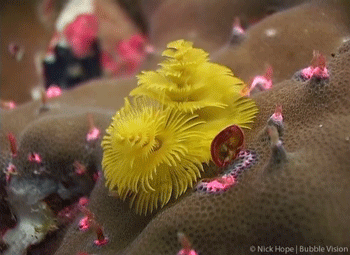
(GIF: a bright yellow Christmas tree worm retracting into its tube. The full retraction takes less than a second and leaves only a hole covered by the operculum. End ID)
Christmas tree worms are considered to have a stable population, but as they are dependent on corals, threats to reefs are threats to them. Thus, global climate change is a major threat to their survival. Predators of the worms include fish, starfish, and other worms. They are not of commercial interest to humans, but are popular among divers and have entered the aquarium trade.

(Image: multiple Christmas tree worms of various colors emerging from a coral. End ID)
#wet beast wednesday#christmas tree worm#wormblr#worms#worm#polychaete#annelid#invertebrates#invertiblr#coral reef#christmas#christmas tree#marine biology#biology#ecology#zoology#animal facts#informative#educational#image described
253 notes
·
View notes
Text

Welcome, adventurer. You have come through many perils to find me, the Brain of the Ocean. What wisdom do you wish to acquire?
Grooved Brain Coral (Diploria labyrinthiformis)
Caribbean Sea, Gulf of Mexico, and West Atlantic Ocean
Status: Critically Endangered
#brain coral#coral#ocean invertebrate#ocean life#coral art#coral reef#ocean aesthetic#caribbean#gulf of mexico#atlantic ocean
48 notes
·
View notes
Text

Corals (and Sponges)
Plate V from The World of the Sea
(London, 1869)
Via Biodiversity Heritage Library
#animals in art#european art#19th century art#British art#book plate#lithograph#coral#sponge#corals#sponges#sea creatures#coral reef#invertebrates#marine biology#BHL#natural history art#scientific illustration
29 notes
·
View notes
Text








guiltfreeaquatics on ig
#stim#coral reefs#corals#saltwater aquariums#sfw#purple#pink#red#cnidarians#invertebrates#animals#trypophobia#?#sea creatures#ishy gifs#postish
286 notes
·
View notes
Text

Yellow tube sponge (Aplysina fistularis)
Photo by Alex Mustard
#yellow tube sponge#tube sponge#sponge#aplysina#aplysina fistularis#verongiida#sea sponge#yellow#aquatic#marine#marine life#sea#ocean#coral reef#reef#marine invertebrates#marine animals#nature
189 notes
·
View notes
Text
Do I know anyone here with a saltwater reef tank? Ever had to deal with a flatworm infestation?
I recently got some biopsies from Caribbean Acropora that were losing tissue and dying. These guys are full of flatworms, and while there are several species of flatworm described on corals in the Pacific and in aquaria on Pacific species, I can't find any references that mention a Caribbean variety, or even an Atlantic one, at all. It's pretty difficult to get an ID beyond "flatworm" from routine histology but I might get tissue to sequence using laser capture microdissection that I can compare to other known species.
I think these might be escapees from someone's hobby aquarium, just possibly. It's also possible that they are a native species no one noticed before but the fact that they are such a big aquarium pest has me worried.
This is why we should never dump an aquarium into wild waters or release any kind of pet that isn't native, or even that is but has had contact with non-native species, into the wild. You never know what else you're unleashing. You might be killing coral reefs.
#coral reef#marine invertebrates#marine biology#histology#coral disease#invasive species#Acropora#flatworms#Caribbean coral reef
28 notes
·
View notes
Text
I mean, we are. Animals are. We were all aquatic invertebrates at one point, and we learned to carry around little bits of the ocean inside us, and make them into hard structures to base soft cells around. Corals took this and made stationary reefs. Ancestral animals took it and made tide pools of themselves so they could leave the ocean. So *we* could leave the ocean.
People think "skulls on sticks" and no, no. Your mouth has more in common with a clam than you like to think. Your hollow organs are ponds that your fluids pass through, filled with millions of living creatures. Whatever's between your legs, it's like a gastropod without eyes, slithering in and out of your body in response to stimuli, and the gastropod *with* eyes is directionally opposed to it, following its own senses. The long bits between are long because it's how the reef locomotes to feed both, so that zygote packets can be exchanged and a new coral reef can be ejected to preserve the old one before it dies.
All so we could live on land, the minimal third of this green planet.
We are aliens in a strange land. It's honestly very comforting.
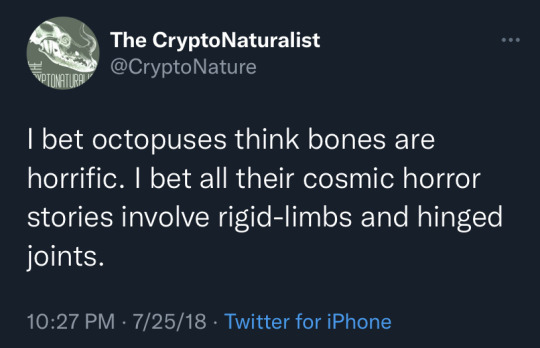
I bet octopuses think bones are horrific. I bet all their cosmic horror stories involve rigid-limbs and hinged joints.
#biology#Evolution#Cells#Cell#Coral reef#Coral#Invertebrates#Vertebrates#Anatomy#Hyperfixation#Hyperfocus#I am never not thinking about this#not for lack of trying#We are all ponds
135K notes
·
View notes
Text

Torch Coral
#artists on tumblr#sea creature art#deep sea creatures#marine invertebrates#coral#coral reef#torch coral#euphyllia magenta
1 note
·
View note
Text

The Science Research Diaries of S. Sunkavally, page 376.
#boring organisms#littoral rock#tidal pools#acid rain#cyanobacteria#hexose monophosphate shunt#NADPH#superoxide reduction#coral reefs#coelenterates#giant electric ray#North Atlantic#Denmark#Kattegat area#invertebrate predators#satyendra sunkavally#starfish#food consumption
0 notes
Note
Wait, which animals raise livestock?
Several species of ants will 'herd' aphids around (a type of plant lice)- even picking them up and putting them back with the group if they wander off. The ants will attack anything that approaches their aphid herds, defending them. The aphids produce a sugary excretion called honeydew, which the ants harvest and eat.
Some ants will even 'milk' the aphids, stroking the aphids with their antennae, to stimulate them to release honeydew. Some aphids have become 'domesticated' by the ants, and depend entirely on their caretaker ants to milk them.
When the host plant is depleted of resources and dies, the ants will pick up their herd of aphids and carry them to a new plant to feed on - a new 'pasture' if you will.
Some ants continue to care for aphids overwinter, when otherwise they'd die. The ants carry aphid eggs into their own nests, and will even go out of their way to destroy the eggs of aphid-predators, like ladybugs.
--
Microhylids – or narrow-mouthed frogs - have an interesting symbiosis with Tarantulas.
While the spiders could very easily kill and eat the much-tinier frogs, and DO normally prey on small frogs, young spiders instead will use their mouthparts to pick up the microhylid frogs, bring them back to their burrow, and release them unharmed.
The frog benefits from hanging out in/around the burrow of the tarantula, because the tarantula can scare away or eat predators that normally prey on tiny frogs, like snakes, geckos, and mantids. The tarantula gets a babysitter.
Microhylid frogs specialize in eating ants, and ants are one of the major predators of spider eggs. By eating ants, the frogs protect the spider's eggs. The frogs can also lay their eggs in the burrow, and won't be eaten by the spider.
So it's less 'livestock' and more like a housepet - a dog or a cat. You stop coyotes/eagles from hurting your little dog/cat, and in return the dog/cat keeps rats away from your baby.
--
Damselfish grow algae on rocks and corals. They defend these gardens ferociously, and will attack anything that comes too close - even humans. They spend much of their time weeding the gardens, removing unwanted algaes that might overtake their crop.
The species of algae that they cultivate is weak and and sensitive to growing conditions, and can easily be overgrazed by other herbivores. That particular algae tends to grow poorly in areas where damselfish aren't around to protect and farm it.
Damselfish will ALSO actively protect Mysidium integrum (little shrimp-like crustacians) in their reef farms, despite eating other similarly sized invertebrates. The mysids are filter feeders, who feed on zooplankton and free-floating algae, and their waste fertilizes the algae farms. Many types of zooplankton can feed on the algae crop, and the mysids prevent that.
While Mysids can be found around the world, the only place you'll find swarms of Musidium integrum is on the algae farms that Damselfish cultivate.
Damselfish treat the little mysids like some homesteaders treat ducks. Ducks eat snails and other insect pests on our crops, and their poop fertilizes the land. The ducks can be eaten, but aren't often, since they're more useful for their services than their meat.
--
There are SEVERAL species of insect and animal which actively farm. They perform fungiculture and horticulture: deliberately growing and harvesting fungus and plants at a large-scale to feed their population.
Leaf-cutter ants and Termites both chew up plant material and then seed it with a specific type of fungus. The fungus grows, and the termites/ants harvest the mushroom as a food source.
Ambrosia beetles burrow into decaying trees, hollow out little farming rooms, and introduce a specific fungii (the ambrosia fungi), which both adults and larval beetles feed on.
Marsh Periwinkles (a type of snail) cultivates fungus on cordgrass. They wound the plant with their scraping tongue, then defecate into the wound so their preferred fungus will infect it and grow there. They let the fungus grow in the wound a bit, and come back later to eat.
9K notes
·
View notes
Text
Planet Earth - Our Home in Focus - Clownfish & Sea Anemone
Watch the first episode of my new video series ‘Planet Earth – Our Home in Focus’ – featuring the fabulous Clownfish & SeaAnemone 🪸🐠 Clownfish & Sea Anemone Illustration 🐠 Gabrielle Ahern #saltywave #sciencevideo #visualstoryteller #exploremore #seacreatures #ocean #oceansounds #oceanwildlife #fish #invertebrates #coralreefs #biodiversity #clownfish #seaanemone #marineconservation #invertebratezoology

View On WordPress
#saltywave#clownfish#coral reef#explore#fish#invertebrate#sciencestory#sea anemone#visualstoryteller
0 notes
Text

Make way for the granulated sea star (Choriaster granulatus)! Growing to about 10 in (25 cm) in size, it's also known as the “doughboy starfish” for its portly look. This species hangs out around reef habitats in shallow Indo-Pacific waters. On its menu are coral and other small invertebrates—it sometimes even scavenges dead animals.
Photo: Sara Simmonds, CC BY-NC 4.0, iNaturalist
#nature#science#natural history#animals#fact of the day#did you know#animal facts#sea star#starfish#marine life#marine biology#cool animals
1K notes
·
View notes
Text

Staghorn Coral (Acropora cervicornis)
West Atlantic, Caribbean Sea
Status: Critically Endangered
Threats: ocean warming
they're pretty cute. interesting. kind of a homebody. but mostly - have you SEEN the rack they've got?
These coral are an asexually-reproducing, hermaphroditic organism, so I used the pronoun 'they' in the dumb caption above.
On that note, let me get on a soapbox for just one second.
If you're like me, you might be alarmed and a bit afraid at the anti-transgender frenzy and laws going on in the US right now. (Though perhaps, sadly, not surprised.) If not, I urge you to care.
I saw a graphic a few months back that said "First they came for the trans people, and I spoke up immediately because I've read the rest of the fucking poem."
The laws that are going into effect are scary not just for trans people (who we should be concerned about anyway! I mean, JFC!). But if you look at the concepts of some of this stuff passing in Florida, Missouri, and other places, and the precedents they set — bans on adults' freedom to choose their own medical care for their own bodies, parents accused of child abuse for "non-government approved" medical treatment, and more. Fucking scary.
So if you can, and if you're in the US, please see if you can pay attention, whatever that looks like — school board meetings, political candidates, etc. It's not likely to end with just LGBTQ people and more importantly we need to protect trans kids now.
With that, here’s a trans flag coral! ✌🏻

#ocean#coral reef#climate change#oceancore#transgender#coral#atlantic ocean#caribbean#ocean invertebrate
2 notes
·
View notes
Text














Бабочка-енот, лунула — Chaetodon lunula. Бабочка-енот, лунула (Chaetodon lunula, raccoon butterflyfish) — узнаваемая рыба бабочка с красивой, выразительной окраской. Максимальная длина лунулы 21 см. Тело и плавники окрашены в желтый цвет, темнеющий ближе к спине и иногда переходящий практически в черный. На боках от грудных плавников к хвосту идут диагональные темные полосы. На морде контрастная маска: черная полоса, проходящая через лоб и маскирующая глаза, и следующая за ней белая, почти такой же ширины. От заднего края этой белой полосы к основанию спинного плавника тянется сужающаяся черная полоса, окаймленная светло-желтыми участками. На хвостовом стебле округлое черное пятно, переходящее в темное основание спинного плавника. Молодые отличаются более светлым, белесым рострумом и округлым черным пятном на задней лопасти спинного плавника.
Населяет мелководные лагуны и внешние склоны рифов. Держится на глубине до 30 метров, парами или небольшими группами. Одна из немногих бабочек, ведущих ночной образ жизни. Питается преимущественно голожаберными моллюсками, кольчатыми червями и другими донными беспозвоночными, однако нередко поедает коралловые полипы и водоросли. Молодые предпочитают каменистые участки на прибрежных рифах в приливно-оливной зоне.
Дайверы и другие любители коралловых лесов могут встретить этот вид бабочек в лагунах и на внешних склонах рифов Индо-Пацифики: от востока Африки, у Мальдивских островов, далее огибая Австралию, где они обитают у берегов Индонезии, Папуа-Новой Гвинеи и Фиджи, и дальше в Океанию, где их можно лицезреть у Гавайев, а с юга – недалеко от берегов Таити — и это лишь малая доля их мест обитания. Иногда они встречаются на юго-востоке Атлантического океана.
Raccoon butterflyfish, lunula — Chaetodon lunula. Raccoon butterflyfish, lunula (Chaetodon lunula, raccoon butterflyfish) is a recognizable butterfly fish with a beautiful, expressive coloration. The maximum length of the lunula is 21 cm. The body and fins are colored yellow, darkening closer to the back and sometimes turning almost black. On the sides from the pectoral fins to the tail there are diagonal dark stripes. On the muzzle there is a contrasting mask: a black stripe passing across the forehead and masking the eyes, and the following white one, almost the same width. From the rear edge of this white stripe to the base of the dorsal fin there is a tapering black stripe, bordered by light yellow areas. On the caudal peduncle there is a rounded black spot, turning into a dark base of the dorsal fin. Juveniles have a lighter, whitish rostrum and a rounded black spot on the back lobe of the dorsal fin.
Inhabits shallow lagoons and outer reef slopes. Stays at depths of up to 30 meters, in pairs or small groups. One of the few butterflies that lead a nocturnal lifestyle. It feeds mainly on nudibranchs, annelids and other bottom invertebrates, but often eats coral polyps and algae. Juveniles prefer rocky areas on coastal reefs in the tidal-olive zone.
Divers and other coral enthusiasts can encounter this butterfly species in the lagoons and outer reef slopes of the Indo-Pacific: from eastern Africa, near the Maldives, around Australia, where they live off the coasts of Indonesia, Papua New Guinea, and Fiji, and on into Oceania, where they can be seen off Hawaii and, to the south, near the coast of Tahiti, to name just a few of their habitats. They are also occasionally found in the southeastern Atlantic.
Источник: //t.me/+E4YBiErj0A8wOGUy, //www.aqua-shop.ru/live/ morskie_ryby/shchetinozubyue_ryubyu-babochki/prod_H3h60_M, //es.pinterest.com/pin/729301733429659096/, ://vk.com/wall-43552186_885, //www.posterazzi.com/hawaii-school-of-racoon-butterflyfish-chaetodon-lunula-along-reef-posterprint-item-vardpi1989862/.
#fauna#video#animal video#marine life#marine biology#nature#aquatic animals#sea creatures#ocean#sea#fish#Chaetodon lunula#Raccoon butterflyfish#reef#corals#sand#animal photography#beautiful#nature aesthetic#видео#фауна#природнаякрасота#природа#океан#море#Бабочка-енот#рыбы#песок#риф#кораллы
210 notes
·
View notes
Text
Pink Fairy Crab: also known as a "pink hairy squat lobster," this species of crab measures just 1.5cm (about half an inch) long, and it has a uniquely colorful, fuzzy-looking appearance
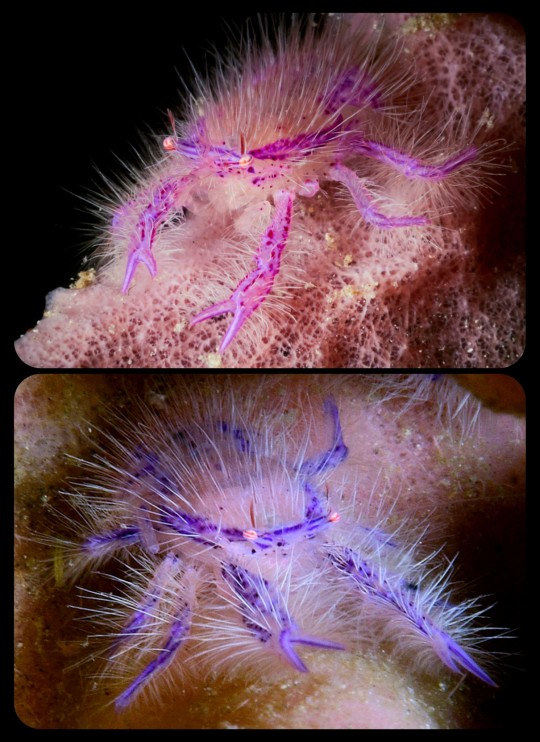
The scientific name of this species is Lauriea siagiani, but it's commonly known as the pink hairy squat lobster or the pink fairy crab. Like all so-called "squat lobsters," it is actually a type of crab (and a particularly flamboyant one, at that).

Pink fairy crabs have a strikingly colorful appearance, with pink, purple, or reddish-orange markings that look almost fluorescent; they also have dark purple "freckles" and bright orange eyes. The crabs themselves are tiny, measuring no more than 1.5cm (about half an inch) long, and their fuzzy little bodies are covered in long, hair-like structures known as setae.
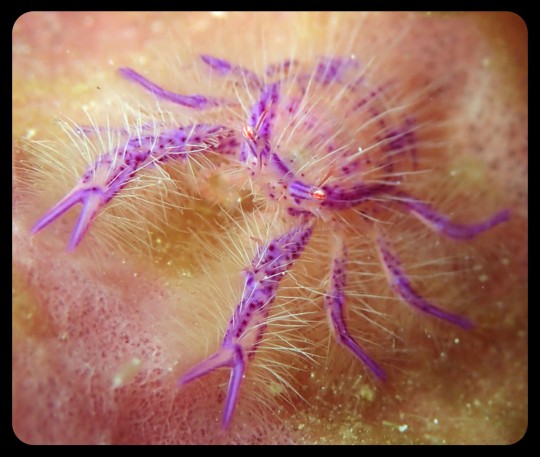
These crabs can be found in the coral reefs around Indonesia, Japan, and the Philippines, where they generally settle into the ridges of giant barrel sponges and feed on various bits of detritus that are collected in their own "fur."
Sources & More Info:
Crustacean Research: Lauriea siagiani, a New Galatheid from Bali, Indonesia (PDF)
Biogeography: Lauriea siagiani from Hachijo-Jima Island, Japan (PDF)
Australian Geographic: This Bewhiskered "Fairy Crab" is the Tiniest Teddy Bear of the Ocean
Macronesia.net: Hairy Squat Lobster
Insects and Other Invertebrates: Lauriea siagiani
Reef Life: Commensalism
Coral Reef Animals of the Indo-Pacific: Lauriea siagiani
#arthropods#crustaceans#fairy crab#pink hairy squat lobster#lauriea siagiani#crabs#pink#animal facts#colorful animals#coral reef#marine life#indonesia#philippines#japan#it looks like a mythical creature
206 notes
·
View notes